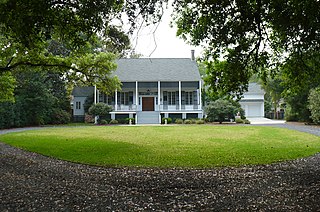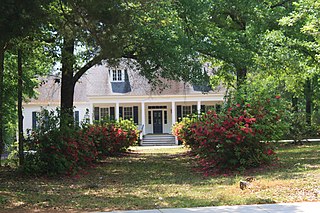The National Register of Historic Places (NRHP) is the United States federal government's official list of districts, sites, buildings, structures and objects deemed worthy of preservation for their historical significance. A property listed in the National Register, or located within a National Register Historic District, may qualify for tax incentives derived from the total value of expenses incurred in preserving the property.

The Auburn University Chapel is the second-oldest building and oldest building in its original location on the campus of Auburn University in Auburn, Alabama.

Green Springs National Historic Landmark District is a national historic district in Louisa County, Virginia noted for its concentration of fine rural manor houses and related buildings in an intact agricultural landscape. The district comprises 14,000 acres (5,700 ha) of fertile land, contrasting with the more typical poor soil and scrub pinelands surrounding it.

The Leinkauf Historic District is a historic district in the city of Mobile, Alabama, United States. It was placed on the National Register of Historic Places on June 24, 1987. It is roughly bounded by Government, Eslava, Lamar, and Monterey Streets. The district covers 1,100 acres (4.5 km2) and contains 303 contributing buildings. The buildings range in age from the 1820s to early 20th century and cover a variety of 19th- and 20th-century architectural styles.

The Campground Historic District, also known as The Campground is a historic district in the city of Mobile, Alabama, United States. Named for the Old Camp Ground, a military encampment that occupied the property during the American Civil War, this historically African-American neighborhood was placed on the National Register of Historic Places on July 7, 2005. It is roughly bounded by Martin Luther King Jr. Avenue, Rylands Street, St. Stephens Road, and Ann Street. The district covers 370 acres (1.5 km2) and contains 166 contributing buildings. The houses range from shotgun houses to bungalows and date from the late 19th century to the middle 20th century.

The Beal–Gaillard House is a historic house located at 111 Myrtlewood Lane in Mobile, Alabama. It is locally significant as an excellent example of a large country home constructed before the widespread use of highly sophisticated moldings and columnar orders.

The Collins–Robinson House is a historic residence in Mobile, Alabama. It was built in 1843 in a Creole cottage style. It was placed on the National Register of Historic Places on October 18, 1984, as a part of the 19th Century Spring Hill Neighborhood Thematic Resource.

Saint Paul's Episcopal Chapel is a historic Episcopal church building in Mobile, Alabama, United States. It was built in 1859 in a vernacular Gothic Revival style. The building was placed on the National Register of Historic Places as a part of the 19th Century Spring Hill Neighborhood Thematic Resource on October 18, 1984.

Stewartfield is a historic residence on the campus of Spring Hill College in Mobile, Alabama, United States. It was built in 1849 in a Greek Revival style. The building was placed on the National Register of Historic Places as a part of the 19th Century Spring Hill Neighborhood Thematic Resource on October 18, 1984.

Wood End Light Lookout Station is a historic lighthouse, located at the southwest end of Long Point in Provincetown, Massachusetts. It is located at Wood End, near the southernmost extent of the Provincetown Spit, and acts as a navigational aid to vessels on their approach to Provincetown Harbor. The Long Point Light Station, further down the peninsula at the tip of Long Point is an identical design and completed in 1875, three years after Wood End Light.

The Spring Hill College Quadrangle is a grouping of historic structures on the campus of Spring Hill College in Mobile, Alabama, United States. The original main building was constructed in 1831 in the Greek Revival style, but burned in 1869. It was replaced within the year by a new main building on the same site in a Neo-Renaissance style. St. Joseph's Chapel was built c.1910 in the Gothic Revival style on the northern side of the quadrangle, with the main building on the southern side. The perimeter of the quadrangle is enclosed by an open arched arcade, topped by crenellation. The grouping was placed on the National Register of Historic Places on August 17, 1973.

The Cavallero House is a historic residence in Mobile, Alabama. It was built in 1835 in the Federal style. A cast-iron gallery was added in the mid-19th century. The house was added to the National Register of Historic Places on October 7, 1982. In addition to be individually listed in the National Register, the house is also a contributing building to the Lower Dauphin Street Historic District.

The Oak Hill Cemetery Chapel, also known as the Renwick Chapel or James Renwick Chapel, is a historic building in the Georgetown neighborhood of Washington, D.C., United States. Designed by James Renwick, Jr. in 1850, Oak Hill Cemetery Chapel is the architect's only known example of Gothic Revival church architecture in Washington, D.C. It is located on the highest ridge in Oak Hill Cemetery, near the intersection of 29th and R Streets NW. The chapel is one of two structures in Oak Hill Cemetery listed on the National Register of Historic Places, the other being the Van Ness Mausoleum. The chapel, mausoleum, and cemetery are contributing properties to the Georgetown Historic District, a National Historic Landmark.

The Center–Gaillard House is a historic residence in Mobile, Alabama. The earliest part of the house was built in 1827. It was placed on the National Register of Historic Places on October 18, 1984, as a part of the 19th Century Spring Hill Neighborhood Thematic Resource.

The Collins–Marston House is a historic house located at 4703 Old Shell Road in Mobile, Alabama.

The Pfau–Crichton Cottage, best known as Chinaberry, is a historic cottage in Mobile, Alabama. The 1+1⁄2-story, wood-frame, Gulf Coast cottage was completed in 1862. The house was built by the Pfau family, but its best known resident was Miss Anne Randolph Crichton, known for the elaborate gardens that she developed on the property. She enlisted in the Navy at the outbreak of World War I and continued her service until retirement, in the 1950s. She traveled extensively in Europe during the 1930s, maintaining scrapbooks that recorded her visits to various art museums, gardens, and monuments. She was the last direct descendant of Hugh Randolph Crichton, the founder of the Mobile County town of Crichton. The house was added to the National Register of Historic Places on October 18, 1984 as a part of the 19th Century Spring Hill Neighborhood Thematic Resource listing of well-preserved buildings that represent the historical development of what was once the village of Spring Hill.

St. Mary's Chapel is a historic Episcopal chapel located at 900 Hillsborough Street in Raleigh, North Carolina, United States. The chapel is on the grounds of St. Mary's School, a college-preparatory boarding and day school founded in the 1840s. The 19th century building was designed by architect Richard Upjohn in the Gothic Revival style and later expanded. It was added to the National Register of Historic Places (NRHP) in 1970.
The 19th Century Spring Hill Neighborhood Thematic Resource is a multiple property submission of buildings that were listed together on the National Register of Historic Places. It covers eight properties in the Spring Hill neighborhood of Mobile, Alabama, all built during the mid-19th century.

Spring Hill is a neighborhood of Mobile, in Mobile County, Alabama. Located on a tall broad hill 6 miles (10 km) to the west of downtown Mobile, it has one of the highest elevations in the area. Originally a summer retreat community, it was eventually encompassed and annexed by the City of Mobile after 1820. It gained its name from a number of natural springs at the site.























